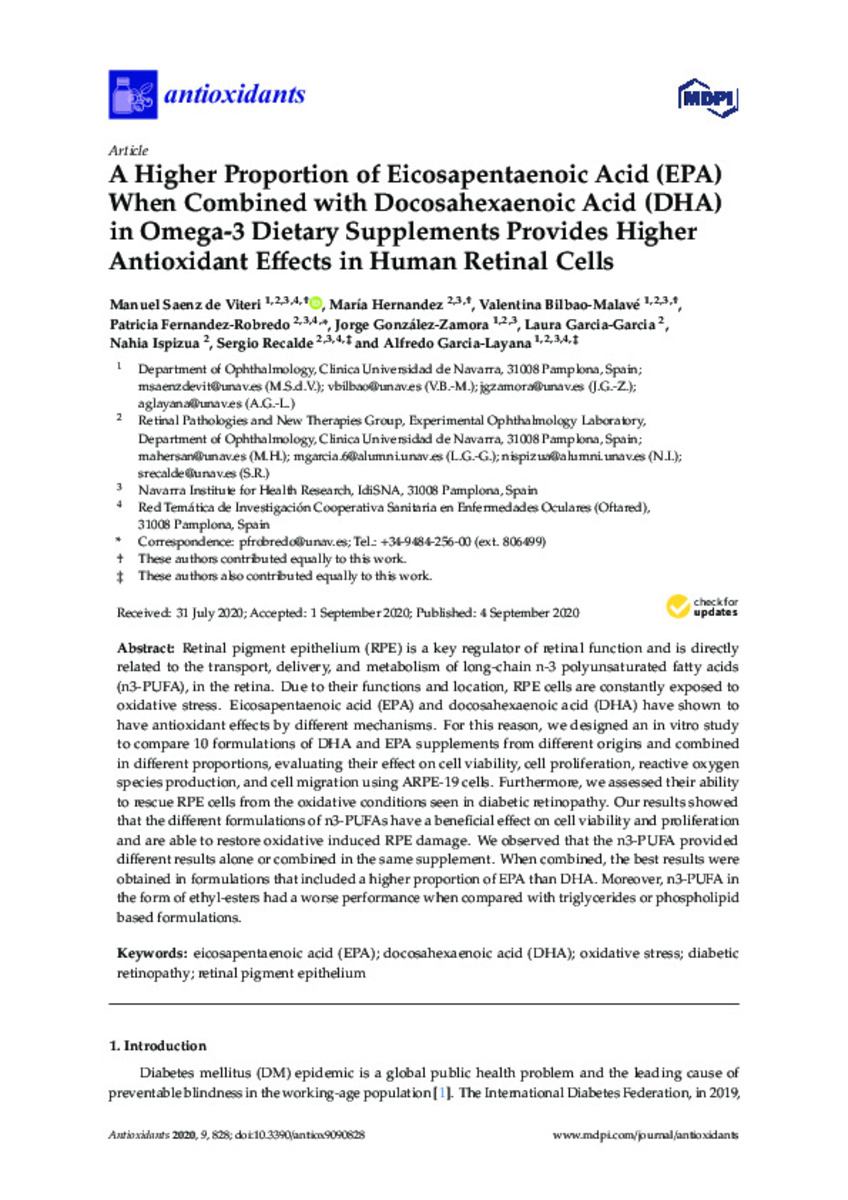Full metadata record
| DC Field | Value | Language |
|---|---|---|
| dc.creator | Saenz-de-Viteri, M. (Manuel) | - |
| dc.creator | Hernandez, M. (María) | - |
| dc.creator | Bilbao-Malavé, V. (Valentina) | - |
| dc.creator | Fernandez-Robredo, P. (Patricia) | - |
| dc.creator | González-Zamora, J. (Jorge) | - |
| dc.creator | Garcia-Garcia, L. (Laura) | - |
| dc.creator | Ispizua, N. (Nahia) | - |
| dc.creator | Recalde, S. (Sergio) | - |
| dc.creator | Garcia-Layana, A. (Alfredo) | - |
| dc.date.accessioned | 2023-02-13T13:21:32Z | - |
| dc.date.available | 2023-02-13T13:21:32Z | - |
| dc.date.issued | 2020 | - |
| dc.identifier.citation | Saenz-de-Viteri, M. (Manuel); Hernandez, M. (María); Bilbao-Malavé, V. (Valentina); et al. "A Higher Proportion of Eicosapentaenoic Acid (EPA) When Combined with Docosahexaenoic Acid (DHA) in Omega-3 Dietary Supplements Provides Higher Antioxidant Effects in Human Retinal Cells". Antioxidants. 9 (9), 2020, 828 | es_ES |
| dc.identifier.issn | 2076-3921 | - |
| dc.identifier.uri | https://hdl.handle.net/10171/65410 | - |
| dc.description.abstract | Retinal pigment epithelium (RPE) is a key regulator of retinal function and is directly related to the transport, delivery, and metabolism of long-chain n-3 polyunsaturated fatty acids (n3-PUFA), in the retina. Due to their functions and location, RPE cells are constantly exposed to oxidative stress. Eicosapentaenoic acid (EPA) and docosahexaenoic acid (DHA) have shown to have antioxidant effects by different mechanisms. For this reason, we designed an in vitro study to compare 10 formulations of DHA and EPA supplements from different origins and combined in different proportions, evaluating their effect on cell viability, cell proliferation, reactive oxygen species production, and cell migration using ARPE-19 cells. Furthermore, we assessed their ability to rescue RPE cells from the oxidative conditions seen in diabetic retinopathy. Our results showed that the different formulations of n3-PUFAs have a beneficial effect on cell viability and proliferation and are able to restore oxidative induced RPE damage. We observed that the n3-PUFA provided different results alone or combined in the same supplement. When combined, the best results were obtained in formulations that included a higher proportion of EPA than DHA. Moreover, n3-PUFA in the form of ethyl-esters had a worse performance when compared with triglycerides or phospholipid based formulations. | es_ES |
| dc.description.sponsorship | The present work was partially funded by Thea Laboratoires and partially supported by RETICS (RD16/0008) from ISCIII, Ministerio de Economía y Competitividad, Spain. | es_ES |
| dc.language.iso | eng | es_ES |
| dc.publisher | MDPI | es_ES |
| dc.relation | info:eu-repo/grantAgreement/MINECO/Ayudas a Redes Temáticas de Investigación Cooperativa RETICS (AE de Salud 2016)/RD16/0008/0011/ES/OFTARED/ | es_ES |
| dc.rights | info:eu-repo/semantics/openAccess | es_ES |
| dc.subject | Eicosapentaenoic acid (EPA) | es_ES |
| dc.subject | Docosahexaenoic acid (DHA) | es_ES |
| dc.subject | Oxidative stress | es_ES |
| dc.subject | Diabetic retinopathy | es_ES |
| dc.subject | Retinal pigment epithelium | es_ES |
| dc.title | A higher proportion of eicosapentaenoic acid (EPA) when combined with docosahexaenoic acid (DHA) in omega-3 dietary supplements provides higher antioxidant effects in human retinal cells | es_ES |
| dc.type | info:eu-repo/semantics/article | es_ES |
| dc.description.note | This article is an open access article distributed under the terms and conditions of the Creative Commons Attribution (CC BY) license | es_ES |
| dc.identifier.doi | 10.3390/antiox9090828 | - |
| dadun.citation.number | 9 | es_ES |
| dadun.citation.publicationName | Antioxidants | es_ES |
| dadun.citation.startingPage | 828 | es_ES |
| dadun.citation.volume | 9 | es_ES |
| dc.identifier.pmid | 32899655 | - |
Files in This Item:
Statistics and impact
Items in Dadun are protected by copyright, with all rights reserved, unless otherwise indicated.






